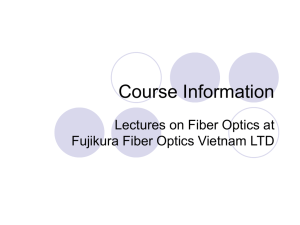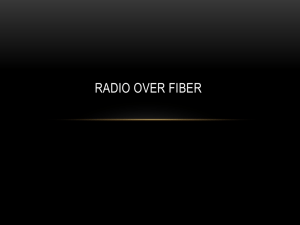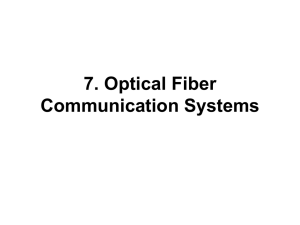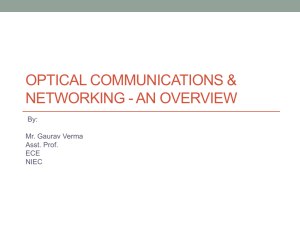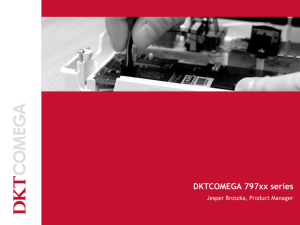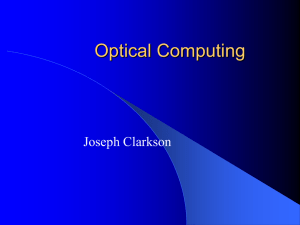Fig. 4-1: Pure-crystal energy
advertisement
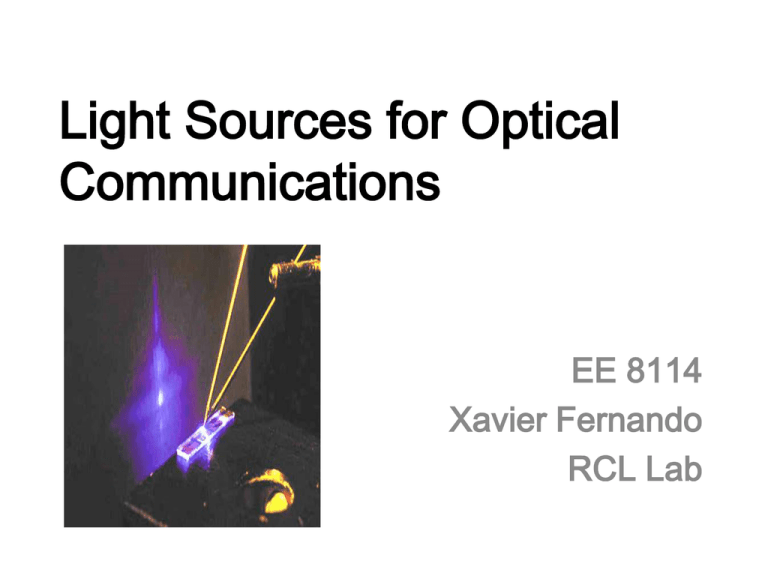
Light Sources for Optical Communications EE 8114 Xavier Fernando RCL Lab Requirements • Small physical dimensions to suit the fiber • Narrow beam width to suit fiber NA • Narrow spectral width (or line width) to reduce chromatic dispersion • Fast response time (high bandwidth) to support high bit rate • High output power into the fiber for long reach without repeaters Considerations … • Ability to directly modulate by varying driving current • Linearity (output light power proportional to driving current) important for analog systems • Stability LED better than LASER • Driving circuit issues impedance matching • Reliability (life time) and cost Solid State (Semiconductor) Light Sources • Light Emitting Diode (LED) Simple forward biased PN junction hc 1.24 E g h eV ( m) • LASER Enhanced LED to achieve stimulated emission that provides: – Narrow line and beam widths, high output power and coherent light Energy-Bands kB 1.381023 JK -1 • • Pure Group. IV (intrinsic semiconductor) material has equal number of holes and electrons. Thermal excitation of an electron from the valence band to the conduction band enable it to freely move. n-type material • • Donor level in an n-type (Group V) semiconductor. The ionization of donor impurities creates an increased electron concentration distribution. p-type material • Acceptor level in an p-type (Group III) semiconductor. • The ionization of acceptor impurities creates an increased hole concentration distribution Intrinsic & Extrinsic Materials Intrinsic material: A pure material with no impurities. n p ni exp( Eg 2k BT ) n & p & ni are theelectron,hole& intrinsicconcentrat ions respectively. Eg is thegap energy,T is Temperatur e. • Extrinsic material: donor or acceptor type semiconductors. pn ni 2 • Majority carriers: electrons in n-type or holes in p-type. • Minority carriers: holes in n-type or electrons in p-type. • The operation of semiconductor devices is essentially based on the injection and extraction of minority carriers. Indirect Band Gap Semiconductors E E E CB Direct Bandgap Ec Eg Indirect Bandgap, Eg CB Photon Ev kcb VB –k k (a) GaAs –k VB kvb (b) Si CB Ec Er Ev k Ec Phonon Ev VB –k k (c) Si with a recombination center (a) In GaAs the minimum of the CB is directly above the maximum of the VB. GaAs is therefore a direct bandgap semiconductor. (b) In Si, the minimum of the CB is displaced from the maximum of the VB and Si is an indirect bandgap semiconductor. (c) Recombination of an electron and a hole in Si involves a recombination center . © 1999 S.O. Kasap,Optoelectronics(P rentice Hall) Direct-bandgap materials (often III-V semiconductors) ensure high quantum efficiency,. Semiconductor Physics • LEDs and laser diodes consist of a pn junction constructed of directbandgap III-V materials. • When the pn junction is forward biased, electrons and holes are injected into the p and n regions, respectively. • The injected minority carriers recombine either, 1. 2. radiatively (a photon of energy E = h is emitted) or nonradiatively (heat is emitted). The pn junction is known as the active or recombination region. Wavelength Bands and Materials Band Description Wavelength range O band original 1260–1360 nm E band extended 1360–1460 nm S band short wavelengths 1460–1530 nm C band conventional (“erbium window”) 1530–1565 nm L band long wavelengths 1565–1625 nm U band ultralong wavelengths 1625–1675 nm Physical Design of an LED • An LED emits incoherent, non-directional, and unpolarized spontaneous photons. • An LED does not have a threshold current. • Double hetero structure (2 p type and 2 n type materials) is used to improve light output • Each region shall also have the right refractive index to guide the light (optical property) • Light exits via the surface (SLED) or the edge (ELED) Double-Heterostructure configuration Light-Emitting Diodes LED features: • Made of GaAlAs (850 nm) or InGaAsP (S-L bands) • Broad spectral output (50 to 150 nm) • Optical output powers less than -13 dBm (50 μW) • Can be modulated only up a few hundred Mb/s • Less expensive than laser diodes • Edge-emitter or surface emitter structures Ratio between Semiconductors Relationship between the crystal lattice spacing, Eg, emission λ at room temp. The shaded area is for the quaternary alloy In1–xGaxAsyP1–y Eg 1.35 0.72y 0.12y 2 y 2.2 x 0 x 0.47 For Ga1 x Alx As E g 1.424 1.266x 0.266x 2 Bandgap Energy The source emission wavelength depends on the bandgap energy of the device material. 16 Bandgap Energy For In1–xGaxAsyP1–y compositions that are latticematched to InP, the bandgap in eV varies as Eg 1.35 0.72y 0.12y 2 y 2.2 x 0 x 0.47 Bandgap wavelengths from 920 to 1650 nm are covered by this material system. 17 Surface and Edge Emitting LED Generally an LED is a broadband light source 18 Rate equations and Quantum Efficiency of LEDs When there is no external carrier injection, the excess density decays exponentially due to electron-hole recombination. n(t ) n0et / n(t) n is the excess carrier density, n0 : initialinjectedexcesselectrondensity : carrierlifetime. t dn n Bulk recombination rate R: R dt With an external supplied current density of J the rate equation for the electron -hole recombination is: dn(t ) J n dt qd In equilibrium condition: dn/dt=0 J n qd Bulk recombination rate (R) = Radiative recombination rate (Rr) + Nonradiative recombination rate (Rnr) For exponential decay of excess carriers: Radiative recombination lifetime τr=n/Rr Nonradiative recombination lifetime τnr=n/Rnr n(t) R Rr Rnr 1/τ 1/τ r 1/τ nr For high quantum efficiency, Rr >> Rnr τr << τnr e t / nr e t / r e t / t Quantum Efficiency Internal quantum efficiency is the ratio between the radiative recombination rate and the sum of radiative and nonradiative recombination rates int nr Rr Rr Rnr r nr r Rr int ( Rr Rnr ) I / q Where, the current injected into the LED is I, and q is the charge of an electron. Example Lifetimes Material Rr (cm3/s) τr τnr τ ηint Si 10-15 10 ms 100 ns 100 ns 10-5 GaAs 10-10 100 ns 100 ns 50 ns 0.5 *assuming a lightly doped n-type material with a carrier concentration of 1017 cm-3 and a defect concentration of 1015 cm-3 at T = 300 K • Si is an indirect bandgap material resulting in a small internal quantum efficiency. • The radiative transitions are sufficiently fast in GaAs, (direct bandgap), and the internal quantum efficiency is large. Internal Quantum Efficiency & Optical Power Optical power generated internally in the active region in the LED is equal to the number of photons/seconds (I/q) times energy per photons (hv) times the internal quantum efficiency Pint int I hcI I h int 1.24 int q q [4-9] Pint : Internalopticalpower, I : Injectedcurrent toactiveregion External Efficiency • Only a small portion of internally generated the light exits the LED due to: – Absorption losses α exp(-αl), where α is the absorption coefficient and l is the path length – Fresnel reflection losses, that increases with the angle of incidence – Loss due to total internal reflection (TIR) which results in a small ‘escape cone’ ext # of photonsemittedfromLED # of internallygeneratedphotons Fresnel Reflection • Whenever light travels from a medium of refractive index n1 to a medium of index n2, then Fresnel reflection will happen. • For perpendicular incidence the F. R. is given by, n1 n2 R n1 n2 2 4n1n2 T 2 (n1 n2 ) • R is the Fresnel reflectivity at the fiber-core end face; • T is the Fresnel transmissivity (Note R+T = 1) Note: When the amplitudes of the light is considered, the reflection coefficient r = (n1 – n2)/(n1 + n2) relates the incident and reflected wave. Fresnel Reflection Example In general At the surface of any two material with n1 and n2 ref indices, there will be Fresnel Loss Fresnel Loss = -10 Log (T) 26 LED Light emission cone n2 n1 ext c 1 T ( )(2 sin )d 4 0 4n1n2 T ( ) : FresnelT ransmission Coefficient T (0) (n1 n2 ) 2 If n2 1 ext 1 n1 (n1 1) 2 Pint LED emittedopticalpowr, P ext Pint n1 (n1 1) 2 [4-12] [4-13] [4-14] The fraction of light lies within the escape cone from a point source: Half Power Beam Width (θ1/2) • The angle at which the power is half of its peak value B(1/ 2 ) Bo /2 • L = 1 For Lambertian source B( ) BoCosL ( ) Source-to-Fiber Power Launching • Assume a surface-emitting LED of radius rs less than the fiber-core radius a. • The total optical power Ps emitted from the source of area As into a hemisphere (2π sr) is given by In terms of Ps the optical power coupled into a stepindex fiber from the LED is 30 Modulation of an LED • The response time of an optical source determines how fast an electrical input drive signal can vary the light output level • If the drive current is modulated at a frequency ω and P0 is the power emitted at zero modulation frequency, the optical output power of the device will vary as 3-dB bandwidths P ( f ) Po / 1 (2f ) 2 Optical Power I(f); Electrical Power I2(f) Electrical Loss = 2 x Optical Loss Modulation of LED • The frequency response of an LED depends on: 1- Doping level in the active region 2- Injected carrier lifetime in the recombination region, i . 3- Parasitic capacitance of the LED • If the drive current of an LED is modulated at a frequency of ω, the output optical power of the device will vary as: p() I() ElectricalBW 10log 20log p ( 0 ) I ( 0 ) p : electricalpower, I : electricalcurrent [4-15] • Electrical current is directly proportional to the optical power, thus we can define electrical bandwidth and optical bandwidth, separately. [4-16] P( ) I ( ) OpticalBW 10log 10log P ( 0 ) I ( 0 ) Electrical and Optical Bandwidths Electrical signal (photocurrent) 1 0.707 Fiber Sinuso idal signal Emitt er t Optical Input f = Modulation frequency Pi = Input light power 0 Ph oto detect or Optical Output Po = Output light power t 0 1 kHz 1 MHz 1 GHz 1 MHz 1 GHz f f el Sinuso idal elect rical sign al Po / Pi 0.1 0.05 t 1 kHz fop f An optical fiber link for transmitting analog signals and the effect of disp ersion in the fiber on the bandwidth, fop. © 1999 S.O. Kasap,Optoelectronics (Prentice Hall) Drawbacks of LED • Large line width (30-40 nm) • Large beam width (Low coupling to the fiber) • Low output power • Low E/O conversion efficiency Advantages • Robust • Linear Source-to-Fiber Power Coupling Comparison of the optical powers coupled into two step-index fibers 36 Lenses for Coupling Improvement If the source emitting area is smaller than the core area, a miniature lens can improve the power-coupling efficiency. Efficient lensing method Requires more precise alignment 37 Fiber-to-Fiber Joints • Different modal distributions of the optical beam emerging from a fiber result in different degrees of coupling loss. All modes in the emitting fiber are equally excited. Achieving a steady-state in the receiving fiber results in an additional loss. A steady-state modal equilibrium has been established in the emitting fiber. 38 Mechanical Misalignment • For a receiving fiber to accept all the optical power emitted by the first fiber, there must be perfect mechanical alignment between the two fibers, and their geometric and waveguide characteristics must match precisely. • Mechanical alignment is a major problem in joining fibers. 39 Axial Displacement • Axial or lateral displacement results when the axes of the two fibers are separated by a distance d. • This misalignment is the most common and has the greatest power loss. • For the step-index fiber, the coupling efficiency is simply the ratio of the common-core area to the core end-face area: 40 Optical Fiber Connectors Principal requirements of a good connectors: 1. Low coupling losses. The connector assembly must maintain stringent alignment tolerances to assure low mating losses. These low losses must not change significantly during operation or after numerous connects and disconnects. 2. Interchangeability. Connectors of the same type must be compatible from one manufacturer to another. 3. Ease of assembly. A technician should be able to install the connector easily in a field environment. The connector loss should also be fairly insensitive to the assembly skill of the technician. 4. Low environmental sensitivity. Conditions such as temperature, dust, and moisture should have a small effect on connector-loss variations. 5. Low cost and reliable construction. The connector must have a precision suitable to the application, but its cost must not be a major factor in the fiber system. 6. Ease of connection. One should be able to mate the connector by hand 41 Optical Fiber Connector Types (1) 42 Optical Fiber Connector Types (2) 43 Angular Misalignment • When two fiber ends are separated longitudinally by a gap s, not all the higher-mode optical power emitted in the ring of width x will be intercepted by the receiving fiber. • The loss for an offset joint between two identical step-index fibers is 44


